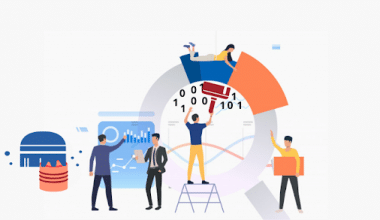A software application that does preprogrammed actions automatically is known as a “bot,” which is an abbreviation for the word “robot.” Bots are able to work on their own or as a component of a larger system, and they are able to communicate with people or with other bots in order to carry out functions or complete tasks. It is necessary to have an understanding of what it is, the many types of bots, how they function, how dangerous they may be, as well as the advantages and disadvantages of utilizing them, all of which are going to be explored in this article.
How Do Bots Work?
Bots are often designed to work on their own, autonomously carrying out the instructions and scripts that have been programmed into them. They have access to a variety of channels, including websites and messaging platforms, via which they can communicate with users. When a command or request is sent to a bot, the bot immediately employs natural language processing algorithms in order to comprehend the user’s purpose and produce an appropriate response. Bots are computer programs that may be taught to carry out a variety of tasks. Some of these tasks include obtaining data from a database, processing transactions, and automating workflows. Through the use of machine learning algorithms, certain bots even have the ability to learn and adapt over time. In order to store information and carry out computations, bots often require a backend server or cloud-based infrastructure to function properly.
What Is the Purpose of Bots?
Depending on how they are programmed and what they do, bots can do a wide variety of tasks. They are able to automate tasks, which both reduces the potential for human error and increases overall productivity. Data entry and web scraping are two examples of repetitive jobs that are well-suited for bot automation. They can also be used to provide customer care and assistance, responding in a timely and helpful manner to the most frequently asked questions. In addition, it can be employed in marketing activities, such as the generation of leads, the transmission of promotional messages, and the interaction with clients via social media. It is also possible for bots to be employed for malevolent activities, such as the transmission of spam or the execution of cyberattacks.
Bots on social media are automated software programs that interact with users and content on social media platforms. They can be designed to perform various functions, such as liking and sharing posts, commenting on content, and following or unfollowing accounts. There are different types of social media bots, including those used for marketing and advertising purposes, as well as malicious bots that spread disinformation, and spam, and conduct cyber attacks. While some bots can be useful for managing social media accounts and engaging with followers, they can also be dangerous when used for malicious purposes. The advantages of using social media bots include increased efficiency and the ability to reach a wider audience, while the disadvantages include the potential for a negative impact on the authenticity of social media interactions and the possibility of account suspension or bans.
What Are Bots and Why Are They a Problem?
Bots are software programs that automate tasks on the internet, but they can also be used for malicious purposes. Malicious bots can spread disinformation, and spam, and conduct cyberattacks. it can also be used to create fake accounts and inflate follower counts, which can mislead users and undermine the authenticity of online interactions. While they can be useful for automating routine tasks and improving efficiency, their malicious use is a significant problem. Some of the advantages of bots include increased productivity and the ability to perform tasks at a scale that is not possible for humans, while their disadvantages include their potential to harm the reputation of companies, erode the authenticity of online interactions, and create security risks.
Is WhatsApp a Bot?
No, WhatsApp is not a bot. Users of WhatsApp are able to have real-time conversations with one another thanks to a messaging application called WhatsApp. However, like other messaging platforms, users can interact with it on WhatsApp which third-party developers create to automate specific tasks or provide information. Users can also add it to their WhatsApp contacts for convenient access. Therefore, while WhatsApp is not a bot itself, users can use it to interact with bots.
Is TikTok a Bot?
No, TikTok is not a bot. TikTok is a platform for social media that enables users to produce and share short films with one another. However, like other social media platforms, there may be bots on TikTok that automate certain tasks, such as liking or commenting on posts, or following and unfollowing users. they are also created by third-party developers and are not part of the official TikTok platform.
Are Bots Hackers?
Not all bots are hackers, but some of them are for malicious purposes, such as conducting cyberattacks or spreading malware. it can also be programmed to perform automated tasks, and many are in use for legitimate purposes. However, some bots compromise computer systems, steal sensitive information, or conduct other forms of cybercrime. It is also important to distinguish between bots and hackers. However, it can be in use for both good and bad purposes, while hackers generally have malicious intent.
How Do Bots Make Money?
Bots can also make money in a variety of ways, depending on their type and purpose. Some generate revenue through online advertising or affiliate marketing, while others manipulate financial markets or engage in other forms of fraudulent activity. Additionally, some collect and sell data, or automate tasks in industries such as customer service or healthcare. While bots can offer many advantages, such as increased efficiency and cost savings, they can also pose significant risks, such as the potential for fraud or data breaches. As with any technology, it is important to understand the advantages and disadvantages of bots before using them for any purpose.
Types of Bots
There are several types of bots, including:
#1. Web Crawlers or Spiders
These bots collect data from websites and search engines, often for research or analytics purposes. Web crawlers can quickly and efficiently scan large amounts of data, allowing businesses to gather insights into customer behavior or market trends. However, individuals can also use web crawlers for malicious purposes, such as scraping personal data or intellectual property, and they can put a strain on website servers.
#2. Chatbots
These bots simulate human conversation and are often in use for customer service or support roles. Chatbots can handle routine inquiries and tasks, such as answering frequently asked questions or providing basic information, freeing up human representatives to handle more complex issues. However, chatbots can also limit the ability to understand context and nuance, which can lead to frustrating or unsatisfying user experiences.
Individuals use these bots to automate social media tasks, such as liking posts or following users. Some social media are specifically to generate fake followers or engagement, with the aim of manipulating social media algorithms and boosting the visibility of certain accounts or content. This practice, commonly known as “social media botting,” is often viewed as unethical or deceptive.
#4. Malware
Cybercriminals use these bots to infect and control computers or networks, often for malicious purposes. Malware has the capability to steal data, launch distributed denial-of-service (DDoS) attacks, or install additional malware on a victim’s computer. Cybercriminals typically distribute malware through infected email attachments, malicious websites, or other online channels.
#5. Trading
These bots automate financial trades on stock exchanges or cryptocurrency markets. it can analyze market data and execute trades faster than human traders, potentially resulting in more profitable investments. However, trading bots can also be subject to programming errors or market volatility, which can result in significant losses.
#6. Gaming
These bots automate gameplay, often to gain an advantage over other players. Gaming can perform repetitive tasks or make complex decisions faster than human players, giving their users an edge in competitive online gaming environments. However, gaming can also be viewed as cheating or unethical by other players and may result in account bans or other penalties.
#7. Spam
Individuals use these bots to send large volumes of unsolicited messages or advertisements, often through email or messaging platforms. Spam can be for spreading malware, phishing scams, or other fraudulent activities. They can also be a nuisance for individuals or businesses that receive large volumes of spam messages.
Overall, while bots can offer many advantages in terms of efficiency and automation, they also pose significant risks in terms of privacy, security, and ethics. It is important for users to be aware of these risks and to use bots responsibly and ethically.
Are Bots Dangerous
Bots, like any other technology, can potentially be dangerous if they are not properly designed, deployed, and maintained. However, It is not the bots themselves that pose a threat, but rather the potential risks associated with how they are used. Some of the ways in which bots can be dangerous include:
#1. Security Risks
Bots can be vulnerable to hacking or other types of cyber attacks, which can lead to data breaches or other types of security breaches. Hackers can use it to gain unauthorized access to systems or carry out attacks on other systems.
Individuals can use it to carry out social engineering attacks, in which they impersonate humans to trick people into divulging sensitive information or performing certain actions.
#3. Malicious Activity
Individuals can program it to carry out malicious activities, such as spreading malware or participating in denial-of-service attacks.
#4. Unintended Consequences
If individuals do not properly design or deploy it, unintended consequences can occur. For instance, a bot that automates a certain task could end up causing harm or disruption if the implementation is not proper. Overall, they are not inherently dangerous, but it is essential to carefully consider and mitigate their potential risks. It’s important to implement proper security measures and to carefully monitor them to ensure that they are functioning as intended and not causing harm.
Advantages and Disadvantages of Bots
Bots, which are software applications to automate tasks, can have several advantages and disadvantages. Some of these include:
Advantages:
#1. Efficiency
Bots can perform tasks much faster than humans and can work 24/7 without the need for breaks or rest. Business efficiency and costs may both increase as a result of this.
#2. Consistency
Bots can perform tasks with a high level of consistency, as they follow pre-programmed rules and do not tire. This capability can help individuals reduce errors and ensure that tasks are accurate.
#3. Scalability
Individuals can easily scale bots up or down to handle changing workloads, which can be useful for businesses experiencing fluctuations in demand.
Cost-effectiveness: Bots can be a cost-effective solution for businesses, as they can help to reduce labor costs and increase productivity.
Disadvantages:
#1. Limited Capabilities
Bots are only capable of performing tasks that they have been programmed to do. They cannot adapt to new situations or handle tasks that require complex decision-making or human interaction.
#2. Lack of Empathy
Bots lack the ability to understand human emotions. It may not be able to provide the same level of customer service as human agents.
#3. Security Risks
Bots can also be vulnerable to hacking or other security threats. It can lead to data breaches or other types of cyber attacks.
#4. Over-Reliance
Businesses that rely too heavily on it may become overly dependent on automation and neglect the importance of human judgment and decision-making.
FAQs
How do I tell whether I'm chatting with a bot on WhatsApp?
Examining the profile is the most popular approach to determine whether or not an account is phony. The most basic bot lacks a photo, a link, and any kind of bio. Complex ones use stolen web photos or automated account names.
What functions can a WhatsApp bot perform?
A WhatsApp chatbot is a computer program designed to automatically answer client queries about your products and services, share content, and deliver notifications regarding orders, payments, and shipments on WhatsApp.
Is bot a type of spyware?
Bot software can be used for both good and evil. Many bots offer real services to consumers, while others are meant to install spyware or steal important data.
Related Articles
- AUTOMATED TRADING: How It Works & Best Platforms In 2023tab)
- Trading Bots: Ultimate Guide to the Top 15+ Crypto Trading Bots (Free & Paid)
- TEXTING SPAM: Meaning, Examples & How to Stop It
- What Is A Data Breach? How To Prevent It






